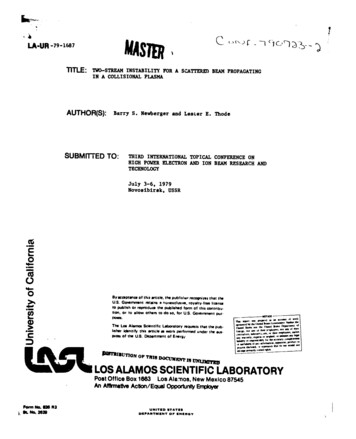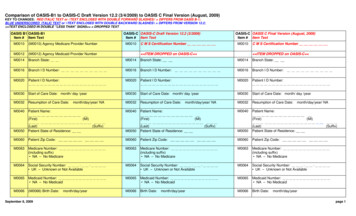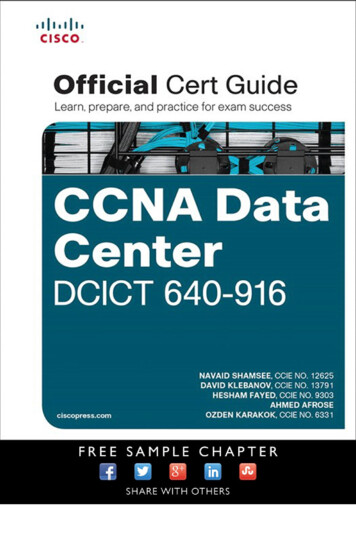
Transcription
be-. AU lm-79-1687mm: STREAMINSTABILITY POR A SCA IN A COLLISIONAL PLASMAAUTHOR(S):W!PROPAGATINGBarry S. Neuberger and Leeier E. ThodeSUBMITTED TO:THIRD INTERNATIONAL TOPICAL CONFERENCE ONHIGN POWER KLECTRON AND ION BEAM RESEARCH ANDTECHNOLOGYJuly 3-6, 1979Novosibirsk, USSR.-6z Byaaptmaofthis uticb,tlwp llslwr U.S. Gownwmnt-to lhhmGgtion,rwtdnsor mprodurnor to dbwm zosthmt onornaclumw.tlw MIlctmdohmro@tv.fwIlmnwform of this mntribu.10 do m, for U.S. wrmrmnt r--.—mumwl.—I c “”—. - .h8t OfficeBOX 1883 Los Alamos, New Mexico 87 -5- ‘--AIIAthmUve Aotkm/Equal OW(MU EqkyIwUNITEDmmPAmTMmdBTATC8T o mmemavI
.TWO-STREAM INSTABILITY FOR A SCATTEREDBEAMPROPAGATING IN A COLLISIONAL PLASMbyBarry S. Newberger and Lester E. ThodeTheoretical DivisionLos Alamos Scientific Laboratory1.IthZSINTRODUCTIONlong been appreciated that the high-frequency( - p)two-stre minstability can be stabilized if the background plasma is sufficiently collisional and the beam has a finite velocity spread.1With a renewed interest inrelativistic electron beams for plasma heating2 and in order to interpret experiments on the propagation of these beams through neutral gases at low pressures ’4 we have been investigating this problem anew.The early calculationwere essentially nonrelativiatic with relativistic ffects modeled in an .—ad hoc way through introduction of an anisotropic mass.Pheuomenological models used to interpret neutral gas propagation experimentsare essentially equivalent to the early, nonrelativistic, Vlasov calculations.In order to put these models in perspective and to provide a linear theory fromwhich nonlinear saturation amplitudes can be obtained by partial numericalsimulation techniques,3 we have been carrying out a rigorous Vlasov theory o!the collisjonal stabilization of the two-stream instability in a relativisticelectron beam. The equilibrium we choose is that of the so-called “scattered”beam2,6for which the electrons are monochromatic in energy but which have adistribution in the directions of their momenta.This distribution is charac-teristic of thJt produced by acatte;ing in an anode foil and, in any case, thequalitative results are likely to be typical of those for other reasonablechoices of relativistic distribution function. The stability of pinched beamscan be estimated by talkingthe mean scattering anfile, , which characterizes thedistribution function to be equal to the betstron angle, ( B/2 A)* where IB isthe beam current and 1A the Alfven current.The beam and plasma are otherwisehomogeneous and infinite in extent.The linear dispersion relation is described in Sec. 11 along with the iowest order correction due to momentum scattet to the cold beam, one-dimensionaldispersion relation.L-J-- - -Somenumerical results are presented in Sec. III and a
II.LINEAR DISPERSION RELATIONIn this section, the linear dispersion relatiou for electrostatic waves inthe beam-plasma system ;a presented.The plasma is characterized by its plasma frequency Up and a (constant)collision frequency v, measured in units of wThe beam is characterized by a eanunits of the lectron rest momentummomentum ?0 Ocas are all frequencies below.(or energy YO (1 Pi) inand a mean scattering angle .Thebeam distribution function6 is taken to bef(;) 6(P- Pn)csch(a)exp(acose)4nP;(1)“where a 2/62 .dispersion relation i.s 1 &p(u) Cb(u,k) where &is the plasmaPdielectric function and Cb that for the beam. The wave number k is measured inTheunits of w / c.polm&p(;) — 2The plasma part is well known:1 ( iThe beam part is.(2)1 v/uJP) orecomplicated.For the 1-D case (propagation along thebeam), it is given byaa kcoth(a) w uacb(w,k) —[a(l - f 2/k2) - 2f Jk]eaw’ky: k U2 - k22y sinh(a) ( {El[a(w/k 1)] - El[a(w/k - l)]]- 2f! [sinh(a)(l/a w/k)where fl (1 - l/Y ), d .np cosh(a)])and El(z)(3)is the exponential integral.6For wave propagating obliquely to the beam, (2-D case) the b-am contribution is arkedly ore complicated. We have-ap cb —I(w,k,a)2yOb2siinh(a)Yokz.and furtheriaa#,(4)
I(u,k,a) (5)-(”2 ‘2”:) - ‘b sand(6)where cos k /k.FI and F2 are given in terms of tabulated transcendental functions by2n-Y-()Xa(7)E2n l(-axa)/where (- lu2/k2)*sinx 8l W ().En(z) is the exponential integral of n’th order’ and 10 is the modified Besselfunction of the firat kind and zero order. The last term provides the analyticcontinuation of &b into the lower half w-plane and the values of the exponentialintegrals are on their principle branch, -n arg(z) S n.We remark that theLandau-like integrals which give rise to the functions FI and F2 (given below)have been considered by direct numerical integration in Ref. 6.The singularnature of the integrals makes numerical integration very difficult and theanalytic continuation to the lower half plane could not be asily extracted.The representation of F2 depends on the value of p xb/j,w/kCOSwhere xb 1 - .For [1 . 1 2, we haveieaYy[l,a(y - xb)]‘2 ‘( ‘{m x(n 11)(3),.(2n - 1) y(n 1/2, a( - xb(2)(4)***(2n)(ia )nP‘1(8)
.-,.where y(a,z) is the incomplete gauunafunction.8mF 21-E (-axb) E ()(-a;) .-.(1)(3). (2n - 1)(-a;) zn l1x [%.n lIf 1 / j 1, then(2)(4)o*o(2n)2n‘ l(-a ) 1(9).The domain of validity of the tworepresentations areFig. 1.illustrated inThere is a finite region ofoverlap in the plane deleted of thepoint p -1.It can be shown thatthe choice of domain of above andthe definitions of Xb nd precludethevalue of p -1.Thereis achoice of branch implicit in Eq. (8).The choice is made by requiring thatthe values of F2 and its derivativebe the same in both representationsin the overlap region.Fig. 1In general, the dispersion rela-Domains of validity in ths complexp-plane of the two representationstion utt be solved numerically; how-of F2. ver, in the 1-D case, it is easy toEq. 8 ,,Eq. 9A\\kboth: .solve for the lowest order correctionto the cold beam dispersion relation.This, limit is defined by a 1, a6 1 where 6 is a typical growth rate (inunits of up).The dispersion relation is in this casea1-1-UJ2(1 v/ul)1y;k2 (w/k - 1)2In the collision-free case.} 2a1y k2a (w/k - 1)3(lo)“(v O), this equation has the solution for thegrowth rate--8 - (1-2where8 #’3Y().()21’3;4ni’36- 24’3e;2ni’3)6(11)
In the collisional case, the growth rate ecomes(12)where nowIi ()(JOv -%yov-1/2i [011/2E —y;vandn-1a.In the limit a CD, the cold beam case, the results above reduce to the wellknown growth rates.gIn both the collisionless case and collisional case, wefind the important result that there are no 0( 2) corrections to the cold beamgrowth rate.Thus, to have corrections of this order appearing in the growthrate, we must have a * 1 at least, This is consistent with our recent results10in the interpretation of the Lawrence Livermore Laboratory Astron experiments.Our requirement that a6 * 1 implies a scattering angle, 0, of about 60 mrad forthe effects of scatter to become important. The Astron beanlhad a of --15 mradand this is consistent with our findings presented in Ref. 10 that the beam wasbehaving essentially as a cold beam.111. NUMERICAL SOLUTIONSIn order to obtain results for general values of the parameters, the dispersion relation must be solved numerically. In the I-D case, we have evaluatedthe collision frequencies necessary for stabilization of the two-stream odeover a wide range of parameters and compared these with the early results. Thescaling over two orders of magnitude in y. are indicated in Table I.to-plasma density ratio has been held fixed at 10-2. a rmaunnnhlvThe beam-twn rmlunlit-
------TA6LL1STABILIZING COLLISION FREQUENCY FORTWO-STREAMINSTABILITY ncy, UCScatteringAngle, eBeam-to-TiasmaDensity Ratio,n@pSinghausCollisio Frequency, V 119.29 0.013.3 x .7 x 10-2RelativisticFactor, 701000aCollisions to stabilize based on Singhaus theory vs 3.04/yo3 /npX10-210-2 02/ 4.bAll frequencies re in units of the plasma frequency. nd the scattering angle has been taken to be the betatron angle. The difference in the scaling of the critical collision frequency between our results andthose based on the arlier models is significant.The mechanism of the collisional stabilization is illustrated in the plotof growth rate as a function of collision frequency presented in Fig. 2.Theparameter values are typical of the IonEPhysic& FX-25diodebeam.4Themeanscattering angle is that to be expectedfrom ?loliere scattering in a 1 mil Tianode foil. The results are qualitatively the same for otherparameter valuesif the mean scattering is such that theinstability in the absence of collisions6is in the quasi-hydrodynamic regime.We observe that the growth rates are onlyweakly affected by collisions until thecollision frequency approaches the critical collision frequency at which pointthegrowthisquenched veryrapidly.Physically, the phase velocity is movedinto the body ofthe distribution by thecollisions and the instability then be,.*Fig. 2Instability “growth rate 6 s afunction of plasma lectron collision frequency.,comes kinetic in character. Only when itis kinetic do the collisions overcome thegrowth of the mode.progressinWe have recently madesolving the 2-D dispersion
irelation given in Sec. II.The results are consistent with this interpretation.We find that at small collision frequencies, the off-axis modes have largergrowth rates out to some value of propagation angle. As the collision frequencyis increased, this cone of angles decreases.When the critical collision fre-quency is approached, the cone is ssentially of zero width with only theparallel mode remaining. This is characteristic of the kinetic regime where the6parallel mode has the largest growth rate.It ust be emphasized, however, thatthe 2-D results are of a very preliminary nature and a thorough study of theinstability in this caae remains to be carried out.Iv.CONCLUSION AND SUHHARYWe have ade significant progress in the understanding of the collisionalstabilization of the high-frequency two-stream instability in a relativisticelectron beam through a rigorous Vlasov treatment.Substantially different scaling with parameters are obtained in comparisonwith previous, essentially phenomenological, odels and we have gained insightinto the echanism of the stabilization process. Further investigation of the2-D case remains to be done.The issue of stabilization of the two-stream in-stability in finite geometry is an yet unexplored as is that of nonlinear saturation, by trapping, of the instability in the presence of momentum spread on thebeam and collisions on the plaama elt?ctrons. These are important in the appli2,11 andcation of relativistic lectron beama to the heating of dense plasmas10possibly in the interpretat.ionof neutral gas propagation xperiments.Extension of our research into these areas will necessarily rely on the investigationsoutlined above.ACKNOWLEDGMENTSThis work wassupported by the Air Force Weapons Laboratory, KirtlandAir Force Base, Albuquerque, New I’lexico.REFERENCES1.H. E. Slughaus, Phys. Fluids , 1534 (1964).2.831 (1976).L. E. ‘rhode,Phys. Fluids l ?-,3.E. P. Lee, F. W. Chambers, L. L. Lodestro, and S. S. Yu, Proceedings Second“International Cmferrnce on High Power Electron and Ion Beam Research andTechnology, Cornell llni ’ersity,p. 381 1977).4.R. J. Briggs, J. C. Clsrk, T. J. Fessenden, R. E. Hester, and E. J. Lauer,Procceding6 Second Inte”nationnl Conference on High Power Electron and IonBeam Research and Technology, Cornell University, p. 319 (1977).
.5,N. G. Platsiborko, I. N. Onishchenko, V. D. Shapiro, and V. I. Shevchenko,Plasma Phys. 14, 591 (1972).6.R. L. Ferch and R. N. Sudan, Plasma Phys. 17, 905 (1975).7.Walter Gautschi and Willinm Cahill, “Exponential Integral and Related Functions,” in Handbook of IlathematicalFunctions, AHS 55, H. Abromovitz and I.A. Stegun, Eds. (National Bureau of Standards, Washington, 1964), Chap. 5,F. 227-252.8.Phillip Davis, “GasunaFunction and Related Functions,” Chap. 6, p. 253-294,ibid.9.S. A. Bludman, K. M. Watson, and I’f.N. Rost?nbluth,Phys. Fluids , 747(1960).10. Barry S. Newberger and Lester E. Thode, LA-7814-MS, Los Alamos Scientific Laboratoryreport (Hay 1979).11. Lester E. Thode, Phys. Fluids 20, 2121 (1977).
U.S. Gownwmnt rwtdns onornaclumw. ro@tv.fw Ilmnw to lhh or mprodurn tlw MIlctmd form ofthis mntribu. -m tion, or to dbw ohm 10do m, for U.S. wrmrmnt r-G mwl.-.—mu — I g c “” —. - . h8t OfficeBOX 1883 LosAlamos,New Mexico87 -5-‘---AIIAthmUve Aotkm/EqualOW(MU EqkyIw UNITED BTATC8 mmPAm TMmd T o mmemav I. This official electronic version was created by scanning the











